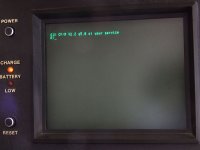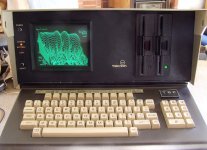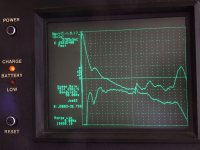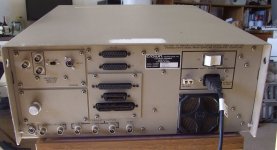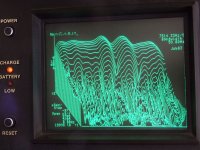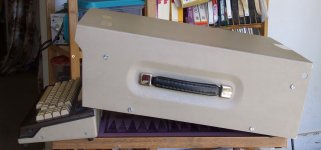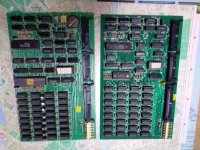I've been thinkng of setting up a rig to do some basic headphone measurements. It occured to me that I have a TEF-10 analyzer sitting in the basement, that I bought new in 1983 and mothballed in 1989 (after upgrading to it's big brother TEF12+). After locating the box of 5.25" floppies it uses , I decided to boot it up and give it a spin. To my great surprise, everything works fine! All of the 33- to 38-yo floppies are also good. This defies everything I've read about floppy data retention.
Thought I'd post some eye candy for those that are unfamiliar with this amazing machine in its day.
The plots are measurements made in 1988. One of them is the anechoic mag and phase response of a polycone tweeter on a test baffle. At 3dB/div, not bad for a cheap driver. The time offset isn't quite dialed in for accurate phase representation - a couple uS off still - but it was close enuf to see that it was minimum phase. The other plot is a 3D "waterfall" display of an unidentified speaker system.
The only thing that makes me think twice about using this system today is the floppy drives.
Thought I'd post some eye candy for those that are unfamiliar with this amazing machine in its day.
The plots are measurements made in 1988. One of them is the anechoic mag and phase response of a polycone tweeter on a test baffle. At 3dB/div, not bad for a cheap driver. The time offset isn't quite dialed in for accurate phase representation - a couple uS off still - but it was close enuf to see that it was minimum phase. The other plot is a 3D "waterfall" display of an unidentified speaker system.
The only thing that makes me think twice about using this system today is the floppy drives.
Attachments
Last edited:
There is a thing which looks like a floppy drive on the PC side but is really flash memory and a button to "change disks". Like $40.think twice about using this system today is the floppy drives.
I can't remember the trade-name of the thing so I am hoping someone else does. If you can transfer the box of diskettes to eRAM, the thing will run faster and for years more.
EDIT: ah-ha.
https://www.newegg.com/p/1B4-0AEF-002R6?Description=floppy drive
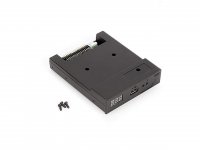
Looks like a 3.5" flop on the back. Front is 0-999 display, button, and USB port. Since you have 5.25" drives, you need plug-converter and 1.44M driver support in the TEF.... and 1983 is not promising.
If you get this far, http://www.deviceside.com/ may be useful.
Last edited:
OMG. I just realized the boot says "CP/M". 2.2 may have been the best of that breed, and you can probably find source code for it, and hack the disk interface. (CP/M had a more general concept of storage than Gates' DOS did.) But it was often compiled on another machine (like a DEC) rather than self-compiled. And editing and compiling is hard on now-precious diskettes.
Still, thanks for the glimpse into a machine I always coveted.
Still, thanks for the glimpse into a machine I always coveted.
In the late '60s, I was an EE student at nearby Purdue University. Some friends and I made a "pilgrimage" to the factory in Elkhart and were given a generous tour. Crown reel-to-reel tape decks were coveted, beyond affordability for poor students. The DC300 was still in the future.
A near religious outing. Thanks for triggering memories.
A near religious outing. Thanks for triggering memories.
Yes that ws my first thought too, but those emulators for the PC would not be plug-n-play here. I have the BIOS source code - it was part of the documentation package - and once upon a time I did quite a bit of Z80 assembler. It was the only way to get things done fast in that world. But a project like this would be a huge undertaking. If I were retired, maybe, but not yet.OMG. I just realized the boot says "CP/M". 2.2 may have been the best of that breed, and you can probably find source code for it, and hack the disk interface. (CP/M had a more general concept of storage than Gates' DOS did.) But it was often compiled on another machine (like a DEC) rather than self-compiled. And editing and compiling is hard on now-precious diskettes.
Still, thanks for the glimpse into a machine I always coveted.
I used to have a good rapport with the guy at Crown who wrote the BIOS and drivers. It would definitely be worth tracking him down and seeing what he says...
Interesting story, thanks for sharing.A near religious outing. Thanks for triggering memories.
Fans of Dick Heyser will want to check this out:
https://www.diyaudio.com/community/threads/video-of-richard-heysers-first-public-tds-demo.382593/
https://www.diyaudio.com/community/threads/video-of-richard-heysers-first-public-tds-demo.382593/
I have a Techron TEF 12 (CPM 2.2, turns on but won't get past the EasyTEF load screen) and a TEF 12 Plus (boots into Tefdos and loads EasyTEF). Techron still has the manuals online in their "legacy" section (and I have hardcopies). Plus I have 4x volumes from the 1987 Pasadena Programming Workshop (including the Turbo Pascal source code EasyTEF).
I wonder if anyone still has the TEF 2.0 and other software for these beasts . . . ??
I wonder if anyone still has the TEF 2.0 and other software for these beasts . . . ??
I have a Techron TEF 12 (CPM 2.2, turns on but won't get past the EasyTEF load screen) and a TEF 12 Plus (boots into Tefdos and loads EasyTEF). Techron still has the manuals online in their "legacy" section (and I have hardcopies). Plus I have 4x volumes from the 1987 Pasadena Programming Workshop (including the Turbo Pascal source code EasyTEF).
I wonder if anyone still has the TEF 2.0 and other software for these beasts . . . ??
I probably do, I'll look tomorrow. The problem is going to be how to get it to you in readable form. My TEF10 can't write TEF12 floppies (different densiry and format).
Here is a link into a number of rabbit holes: http://www.cpm.z80.de/emulate.html (Given what is available for free in Windows you should be cautious about how much time to invest).
Building a suitable headphone test fixture may be a better place to put your effort. I can share what I use (I leave the GRAS artificial ear in its box, too fiddly except when you need to meet international standards).
Building a suitable headphone test fixture may be a better place to put your effort. I can share what I use (I leave the GRAS artificial ear in its box, too fiddly except when you need to meet international standards).
Here is a link into a number of rabbit holes: http://www.cpm.z80.de/emulate.html (Given what is available for free in Windows you should be cautious about how much time to invest).
Hmmm... not sure what I'd need a Z80/CPM emulator for. Definitely do not want to put time into that...
Building a suitable headphone test fixture may be a better place to put your effort. I can share what I use (I leave the GRAS artificial ear in its box, too fiddly except when you need to meet international standards).
Agreed. This got put on the backburner since I first posted this, but I'll come back to you when it rises again, thanks.
Good point!! The TEF 12 and TEF 12 PLUS appear to be identical machines -- with the exception of the CPU card. In the PLUS, the Monitor has been updated from "V17 8-18-83" to "Mon21 TEF12+ 5/15/88" and the (socketed) memory has been bumped-up 4x to 1MB from 64KB. But if the schematics are to be believed, there was only one I/O board, which would be able to read all these densities. So, it's software?I probably do, I'll look tomorrow. The problem is going to be how to get it to you in readable form. My TEF10 can't write TEF12 floppies (different densiry and format).
All my hardware docs are for the Tefdos machines (PLUS), which uses both 790K and 1.4M disks. Is it possible that the TEF 12 (CP/M 2.2, not PLUS) will also read the TEF 10 low-density disks?
FWIW, I found these specs as parameters for something called "fluxengine" (on Github): Techron TEF 10 - DSDD 96 tpi 5.25" - 512 x 10 Techron TEF 12 - DSHD 96 tpi 5.25" - 512 x 17. And there is an extensive list in a diyAudio thread about CP/M boot disks that also highlights the "DD" vs. "HD" difference (w/o sector details). I presume that "512 x 10" means 10 sectors/track, sized 512 bytes (or 17 for the TEF 12).
I also found a Techron System 12 (not PLUS) brochure hidden away on Facebook that mentions "1 MB disks" and didn't say anything about backwards TEF 10 compatibility. Could they have made these machines floppy incompatible . . . ??
I also found a Techron System 12 (not PLUS) brochure hidden away on Facebook that mentions "1 MB disks" and didn't say anything about backwards TEF 10 compatibility. Could they have made these machines floppy incompatible . . . ??
Good point!! The TEF 12 and TEF 12 PLUS appear to be identical machines -- with the exception of the CPU card.
That could very well be. I went from 10 to 12+ so no experience with the plain 12.
In the PLUS, the Monitor has been updated from "V17 8-18-83" to "Mon21 TEF12+ 5/15/88" and the (socketed) memory has been bumped-up 4x to 1MB from 64KB.
Yes, Keith Jebelian significantly expanded the monitor functions in the Plus.
Makes sense.But if the schematics are to be believed, there was only one I/O board, which would be able to read all these densities. So, it's software?
All my hardware docs are for the Tefdos machines (PLUS), which uses both 790K and 1.4M disks. Is it possible that the TEF 12 (CP/M 2.2, not PLUS) will also read the TEF 10 low-density disks?
If you have any 790k disks you could check that out. IIRC, the 1.4M drives are more likely to be able to read the 790k disks than write them.
OK, I found my 'working disks' caddy, and I do have Tefdos-formatted HD disks of TEF 2.0B and the Heyser TEF disk (when I sold my 12+ I gave them the masters but kept working copies). PM me for details.
@AudioGeek67 - unsure if you still have those, but I'd certainly be interested. And apologies for necro-bumping... I've exhausted all of my other options!
Just came across a TEF-12 myself about a week ago. Plugged it in & it turned on just fine. Floppies in it must've worked. Unfamiliar with the machines but I'd gotten to some sort of console.
Turned it off and then back on about four days later to show my girlfriend, and it didn't do anything but emit a high-pitched whine from the CRT. Tooling with the brightness told me that the CRT still works just fine - but not the machine. Came back to it 2 days later, and left it on for about 10 minutes before it started smoking From what I can tell, it blew two caps and a resistor on the A/D board (5983). The caps, C20 & C12, are easy enough to replace... 15V/15uF. But the resistor that burned out is the single unreadable resistor on P2 of the schematics linked here (R71) - https://www.aetechron.com/pdf/service/TEF-schematics.PDF
From what I can tell, it blew two caps and a resistor on the A/D board (5983). The caps, C20 & C12, are easy enough to replace... 15V/15uF. But the resistor that burned out is the single unreadable resistor on P2 of the schematics linked here (R71) - https://www.aetechron.com/pdf/service/TEF-schematics.PDF
I think it's maybe a 1K but can't tell - the bands burned off of mine physically. The only remaining band is either brown or a burnt red, so it could either by a 1K or a 2K and I don't want to risk it (I've also got no idea why these components blew up, and I guess I can only really hope that they just went bad over the years. Next step after replacing is to check all of the voltages, but alas, also not sure where to even find those - so any pointers there would also be amazing. But that's an aside for now). So... all of that said. Would anyone that's still got a unit be willing and able to open up the unit and help me figure out what the resistance of R71 is? I can certainly help guide you as to which board it's on - it's luckily one of the easier boards to access in the machine, IMO.
Just came across a TEF-12 myself about a week ago. Plugged it in & it turned on just fine. Floppies in it must've worked. Unfamiliar with the machines but I'd gotten to some sort of console.
Turned it off and then back on about four days later to show my girlfriend, and it didn't do anything but emit a high-pitched whine from the CRT. Tooling with the brightness told me that the CRT still works just fine - but not the machine. Came back to it 2 days later, and left it on for about 10 minutes before it started smoking
I think it's maybe a 1K but can't tell - the bands burned off of mine physically. The only remaining band is either brown or a burnt red, so it could either by a 1K or a 2K and I don't want to risk it (I've also got no idea why these components blew up, and I guess I can only really hope that they just went bad over the years. Next step after replacing is to check all of the voltages, but alas, also not sure where to even find those - so any pointers there would also be amazing. But that's an aside for now). So... all of that said. Would anyone that's still got a unit be willing and able to open up the unit and help me figure out what the resistance of R71 is? I can certainly help guide you as to which board it's on - it's luckily one of the easier boards to access in the machine, IMO.
Quick addendum to my last comment... R71 may also just not be of the kilo- magnitude? Maybe it is a 22 Ohm. But I still cannot tell. Not sure if/how I can edit a previous response, otherwise, I would've just added this onto that response.
Also forgot to mention that R71, when looking at P2 of the schematics linked above, is approximately in (but slightly under) the middle of the page. Connected to pin 17 of one of the larger chips, the AM 6012 (U1).
Also forgot to mention that R71, when looking at P2 of the schematics linked above, is approximately in (but slightly under) the middle of the page. Connected to pin 17 of one of the larger chips, the AM 6012 (U1).
- Home
- Design & Build
- Equipment & Tools
- Tecron TEF-10 TDS analyzer- it's still alive!
